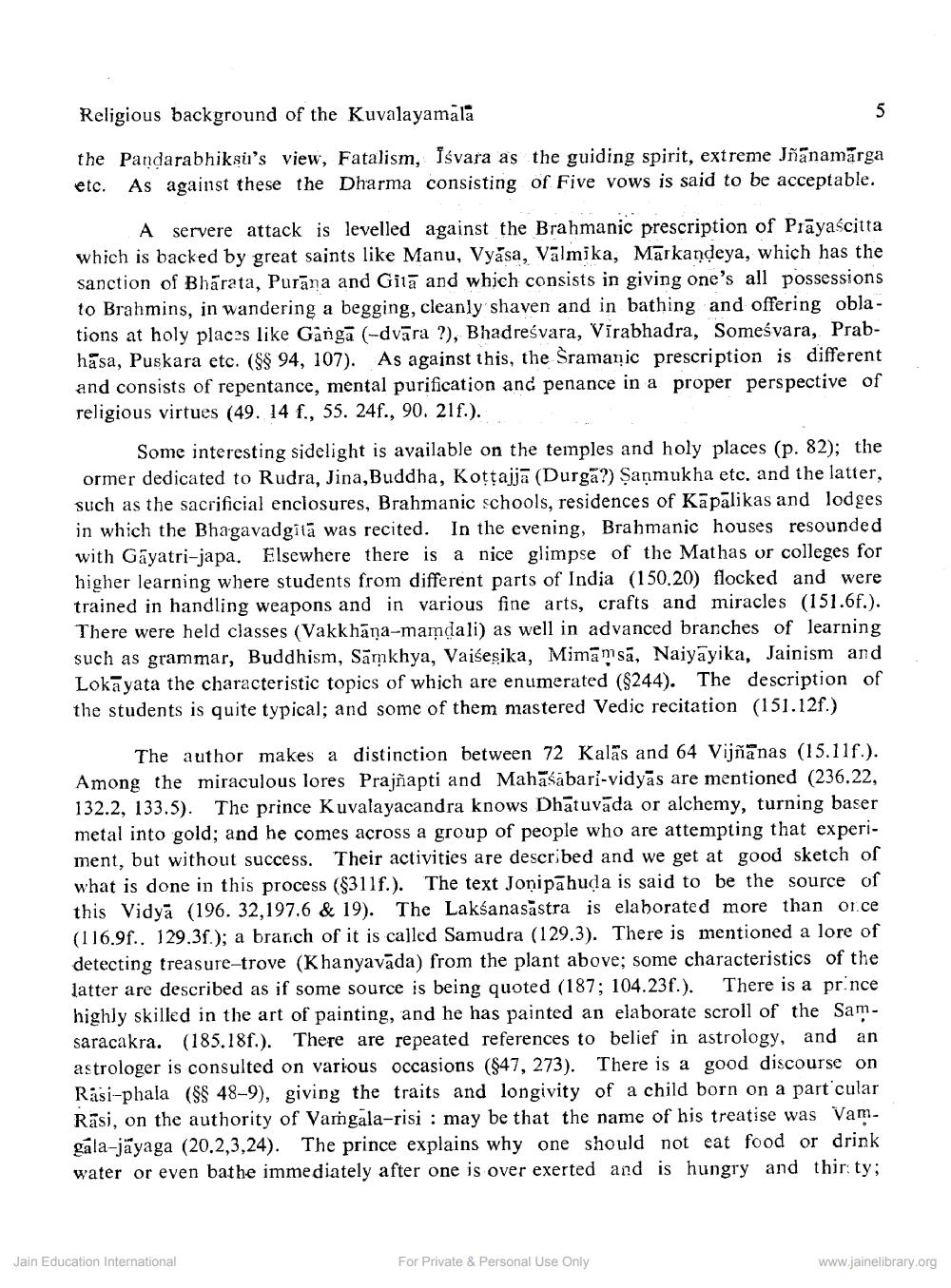________________
Religious background of the Kuvalayamala
the Pandarabhiksu's view, Fatalism, Isvara as the guiding spirit, extreme Jñānamārga etc. As against these the Dharma consisting of Five vows is said to be acceptable.
A servere attack is levelled against the Brahmanic prescription of Prayaścitta which is backed by great saints like Manu, Vyása, Valmika, Mārkandeya, which has the sanction of Bhārata, Purāna and Gilā and which consists in giving one's all possessions to Brahmins, in wandering a begging, cleanly shaven and in bathing and offering oblations at holy places like Ganga (-dvāra ?), Bhadreśvara, Virabhadra, Someśvara, Prabhāsa, Puskara etc. ($$ 94, 107). As against this, the Sramanic prescription is different and consists of repentance, mental purification and penance in a proper perspective of religious virtues (49. 14 f., 55. 24., 90. 21.).
Some interesting sidelight is available on the temples and holy places (p. 82); the ormer dedicated to Rudra, Jina,Buddha, Kottajjā (Durga?) Saņmukha etc. and the latter, such as the sacrificial enclosures, Brahmanic schools, residences of Kāpalikas and lodges in which the Bhagavadgitā was recited. In the evening, Brahmanic houses resounded with Gayatri-japa. Elsewhere there is a nice glimpse of the Mathas or colleges for higher learning where students from different parts of India (150.20) flocked and were trained in handling weapons and in various fine arts, crafts and miracles (151.6f.). There were held classes (Vakkhāna-mamdali) as well in advanced branches of learning such as grammar, Buddhism, Sāmkhya, Vajśesika, Mimamsā, Naiyāyika, Jainism and Lokayata the characteristic topics of which are enumerated ($244). The description of the students is quite typical; and some of them mastered Vedic recitation (151.12f.)
The author makes a distinction between 72 Kalās and 64 Vijña nas (15.11f.). Among the miraculous lores Prajñapti and Mahasabari-vidyās are mentioned (236.22, 132.2, 133.5). The prince Kuvalayacandra knows Dhātuvāda or alchemy, turning baser metal into gold; and he comes across a group of people who are attempting that experiment, but without success. Their activities are described and we get at good sketch of what is done in this process (8311f.). The text Jonipahuda is said to be the source of this Vidya (196. 32,197.6 & 19). The Lakšanasastra is elaborated more than once (116.9f.. 129.3f.); a branch of it is called Samudra (129.3). There is mentioned a lore of detecting treasure-trove (Khanyavāda) from the plant above; some characteristics of the latter are described as if some source is being quoted (187; 104.23f.). There is a prince highly skilled in the art of painting, and he has painted an elaborate scroll of the Samsaracakra. (185.18f.). There are repeated references to belief in astrology, and an astrologer is consulted on various occasions (847, 273). There is a good discourse on Rasi-phala (SS 48-9), giving the traits and longivity of a child born on a part cular Räsi, on the authority of Vargala-risi : may be that the name of his treatise was Vamgala-jayaga (20.2,3,24). The prince explains why one should not eat food or drink water or even bathe immediately after one is over exerted and is hungry and thirty;
Jain Education International
For Private & Personal Use Only
www.jainelibrary.org




